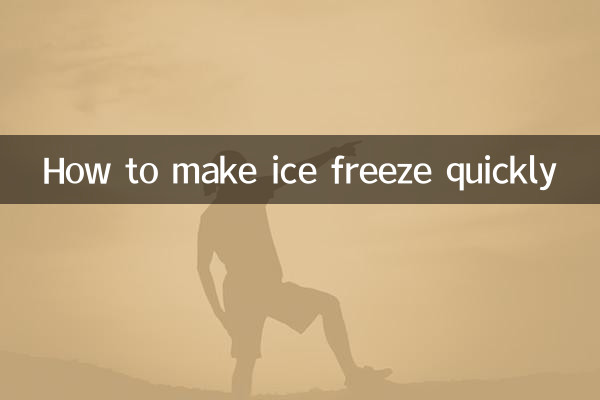Title: How to make ice freeze quickly
In the hot summer, quick ice making becomes the need of many people. Whether it is a family gathering, the catering industry or laboratory research, rapid ice making technology can greatly improve efficiency. This article will combine the hot topics and hot content on the Internet in the past 10 days to analyze the scientific principles and practical skills of rapid ice making.
1. Scientific principles of rapid ice making

Ice formation is a thermodynamic process involving heat transfer and phase changes. The key to making ice quickly is to speed up the heat dissipation from the water. The following are the main factors that affect the speed of ice formation:
| Influencing factors | Principle of action | degree of influence |
|---|---|---|
| temperature | The lower the ambient temperature, the greater the temperature difference, and the faster the heat transfer | ★★★★★ |
| contact area | Increasing the contact area between water and cold source can accelerate heat exchange | ★★★★ |
| water quality | Pure water is more likely to form transparent ice than water containing impurities | ★★★ |
| Container material | Metal containers have better thermal conductivity than plastic containers | ★★★ |
| disturbance | Proper stirring prevents overcooling | ★★ |
2. Practical methods for making ice quickly
1.Pre-cooling container method: First put the ice-making container into the freezer to pre-cool, which can reduce the initial temperature difference and speed up the freezing speed.
2.metal pallet method: Use metal trays instead of plastic ice trays. The high thermal conductivity of metal significantly increases the freezing speed.
3.stratified freezing method: Pour water into a shallow dish to increase the surface area and shorten the freezing time by more than 30%.
4.salt water bath method: Place the container filled with water into a salt water bath. The freezing point of salt water is lower and can take away heat faster.
5.Boiling water ice making method: It may seem counterintuitive, but hot water freezes more easily than cold water (the Mpemba effect), especially under certain conditions.
| method | Operational points | Estimated time shortened |
|---|---|---|
| Pre-cooling container method | Freeze the container for 30 minutes before filling it with water | 15-20% |
| metal pallet method | Use aluminum or stainless steel ice trays | 25-30% |
| stratified freezing method | The water depth does not exceed 1cm | 30-35% |
| salt water bath method | Salt concentration is about 20% | 40-50% |
| Boiling water ice making method | Suitable for specific environmental conditions | 20-25% |
3. Recently popular quick ice making techniques
1.Graphene assisted ice making: The latest research shows that graphene coating can significantly improve heat conduction efficiency and is expected to become a new material for rapid ice production in the future.
2.Ultrasonic ice making technology: Laboratory data shows that ultrasonic waves with specific frequencies can promote the formation of ice nucleation and accelerate the icing process.
3.Intelligent refrigeration system: Some high-end refrigerators are equipped with a rapid ice-making function, which achieves rapid freezing by optimizing air flow and temperature control.
4.Phase change material applications: Utilizing the cold storage properties of phase change materials, more efficient cold transfer can be achieved.
| new technology | principle | Application prospects |
|---|---|---|
| Graphene Assisted | Ultra-high thermal conductivity | commercial refrigeration equipment |
| Ultrasonic technology | Promote nucleation | Industrial ice making |
| Smart freezing | Precise temperature control | household appliances |
| phase change materials | Efficient cold storage | Cold chain logistics |
4. Safety precautions
1. Avoid using glass containers for direct freezing to prevent explosion.
2. The temperature of the freezer should not be set too low, generally -18°C is enough.
3. Defrost regularly to maintain freezing efficiency.
4. Food-grade containers and purified water should be used when eating ice cubes.
Summarize:Making ice quickly is both science and skill. By understanding the principles of heat conduction and choosing appropriate materials and methods, ice making efficiency can be significantly improved. With the development of new technologies, we are expected to see faster and more energy-efficient ice making solutions in the future.

check the details

check the details